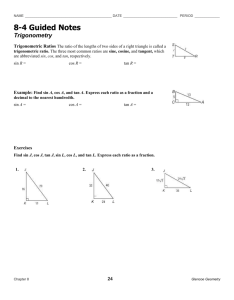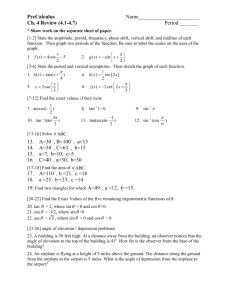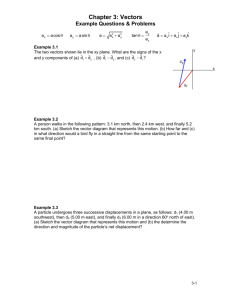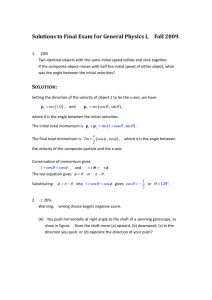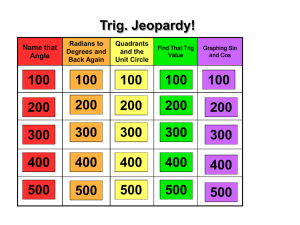Chapter 3
advertisement
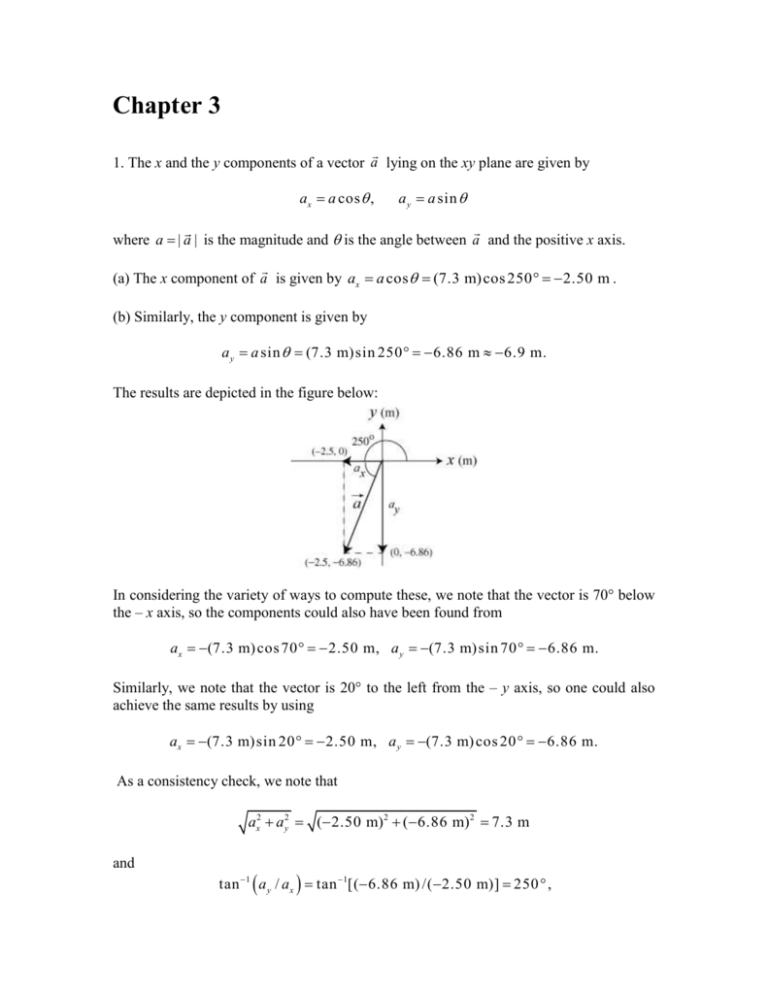
Chapter 3 1. The x and the y components of a vector a lying on the xy plane are given by ax a cos , a y a sin where a | a | is the magnitude and is the angle between a and the positive x axis. (a) The x component of a is given by ax a cos (7.3 m) cos 250 2.50 m . (b) Similarly, the y component is given by a y a sin (7.3 m) sin 250 6.86 m 6.9 m. The results are depicted in the figure below: In considering the variety of ways to compute these, we note that the vector is 70° below the – x axis, so the components could also have been found from ax (7.3 m) cos 70 2.50 m, a y (7.3 m) sin 70 6.86 m. Similarly, we note that the vector is 20° to the left from the – y axis, so one could also achieve the same results by using ax (7.3 m) sin 20 2.50 m, a y (7.3 m) cos 20 6.86 m. As a consistency check, we note that ax2 a y2 ( 2.50 m)2 ( 6.86 m) 2 7.3 m and tan 1 a y / ax tan 1[( 6.86 m) /( 2.50 m)] 250 , which are indeed the values given in the problem statement. 2. (a) With r = 15 m and = 30°, the x component of r is given by rx = rcos = (15 m) cos 30° = 13 m. (b) Similarly, the y component is given by ry = r sin = (15 m) sin 30° = 7.5 m. 3. A vector a can be represented in the magnitude-angle notation (a, ), where a ax2 a y2 is the magnitude and ay ax tan 1 is the angle a makes with the positive x axis. (a) Given Ax = 25.0 m and Ay = 40.0 m, A ( 25.0 m) 2 (40.0 m) 2 47.2 m. (b) Recalling that tan = tan ( + 180°), tan–1 [(40.0 m)/ (– 25.0 m)] = – 58° or 122°. Noting that the vector is in the third quadrant (by the signs of its x and y components) we see that 122° is the correct answer. The graphical calculator “shortcuts” mentioned above are designed to correctly choose the right possibility. The results are depicted in the figure below: We can check our answers by noting that the x- and the y- components of A can be written as Ax A cos , Ay A sin Substituting the results calculated above, we obtain Ax (47.2 m) cos122 25.0 m, Ay (47.2 m) sin122 40.0 m which indeed are the values given in the problem statement. 6. (a) The height is h = d sin, where d = 12.5 m and = 20.0°. Therefore, h = 4.28 m. (b) The horizontal distance is d cos = 11.7 m. 9. All distances in this solution are understood to be in meters. ˆ m. (a) a b [4.0 (1.0)] ˆi [(3.0) 1.0] ˆj (1.0 4.0)kˆ (3.0iˆ 2.0ˆj 5.0 k) ˆ m. (b) a b [4.0 (1.0)]iˆ [(3.0) 1.0]jˆ (1.0 4.0)kˆ (5.0 iˆ 4.0 ˆj 3.0 k) (c) The requirement a b c 0 leads to c b a , which we note is the opposite of ˆ m. what we found in part (b). Thus, c (5.0 ˆi 4.0 ˆj 3.0 k) 11. We write r a b . When not explicitly displayed, the units here are assumed to be meters. (a) The x and the y components of r are rx = ax + bx = (4.0 m) – (13 m) = –9.0 m and ry = ay + by = (3.0 m) + (7.0 m) = 10 m, respectively. Thus r ( 9.0 m) ˆi (10 m) ˆj . (b) The magnitude of r is r | r | rx2 ry2 (9.0 m)2 (10 m)2 13 m . (c) The angle between the resultant and the +x axis is given by ry rx tan 1 1 10.0 m tan 48 or 132 . 9.0 m Since the x component of the resultant is negative and the y component is positive, characteristic of the second quadrant, we find the angle is 132° (measured counterclockwise from +x axis). The addition of the two vectors is depicted in the figure below (not to scale). Indeed, we expect r to be in the second quadrant. 16. (a) a b (3.0 ˆi 4.0 ˆj) m (5.0 ˆi 2.0 ˆj) m (8.0 m) ˆi (2.0 m) ˆj. (b) The magnitude of a b is | a b | (8.0 m) 2 (2.0 m) 2 8.2 m. (c) The angle between this vector and the +x axis is tan–1[(2.0 m)/(8.0 m)] = 14°. (d) b a (5.0 ˆi 2.0 ˆj) m (3.0 ˆi 4.0 ˆj) m (2.0 m) ˆi (6.0 m)ˆj . (e) The magnitude of the difference vector b a is | b a | (2.0 m) 2 (6.0 m) 2 6.3 m. (f) The angle between this vector and the +x axis is tan-1[( –6.0 m)/(2.0 m)] = –72°. The vector is 72° clockwise from the axis defined by î . 46. The vectors are shown on the diagram. The x axis runs from west to east and the y axis runs from south to north. Then ax = 5.0 m, ay = 0, bx = –(4.0 m) sin 35° = –2.29 m, by = (4.0 m) cos 35° = 3.28 m. (a) Let c a b . Then cx ax bx = 5.00 m 2.29 m = 2.71 m and c y a y by = 0 + 3.28 m = 3.28 m . The magnitude of c is c cx2 cy2 2.71m 2 3.28m 4.2 m. 2 (b) The angle that c a b makes with the +x axis is cy cx tan 1 1 3.28 tan 50.5 50. 2.71 The second possibility ( = 50.4° + 180° = 230.4°) is rejected because it would point in a direction opposite to c . (c) The vector b a is found by adding a to b . The result is shown on the diagram to the right. Let c b a. The components are cx bx ax 2.29 m 5.00 m 7.29 m c y by a y 3.28 m. The magnitude of c is c cx2 c 2y 8.0 m . (d) The tangent of the angle that c makes with the +x axis (east) is tan cy cx 3.28 m 4.50. 7.29 m There are two solutions: –24.2° and 155.8°. As the diagram shows, the second solution is correct. The vector c a b is 24° north of west.


